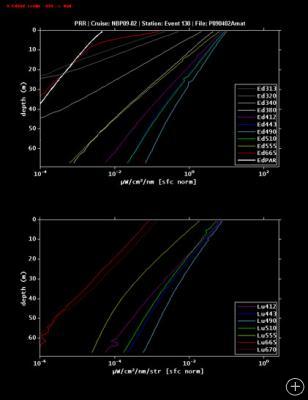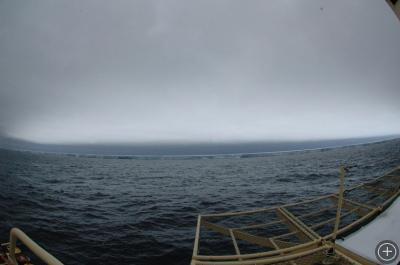It’s a Blue Ocean
March 21th, 2009
ABOARD THE RVIB N. B. PALMER, ON THE SOUTHERN OCEAN– We are all used to thinking of the ocean as blue. Sometimes greenish, if close to the coast, or brownish if a lot of sediments are delivered at a river’s mouth, but mostly it is blue; a clear blue close to coral reefs, a dark blue when seen from space or a grayish blue during a storm. Why is the ocean blue?
During this cruise we measured the underwater light to better understand how icebergs affect the phytoplankton growth environment. All of the colors that make the white light are sensed and measured from surface to 100 m. The first color to disappear is the red, as it is absorbed by water. A few meters under the surface the light loses the red. On the other side of the visible spectrum, ultraviolet light is also rapidly absorbed. By 20 meters depth we are left with purple, blue, green and orange light. As we go deeper only green and blue remain until only blue light is available to plants.

Transmission of different light colors (wavelengths) as taken with a Profiling Radiometer. Each line represents a different wavelength: red is absorbed first (flatter line) and it becomes background at 10 m. Grey lines represent ultraviolet light (below the visible range at less than 400 nm) and each color refers to each corresponding wavelength. The blue line, on the right, with less steepness indicates higher transmission, reaching deeper in the water column.
Phytoplankton use this light to photosynthesize and make new organic carbon, food for animals. All colors of light are usable. As might be expected, phytoplankton absorb blue light very effectively. Light absorbed but not used to drive the biochemical machinery is emitted as fluorescence, as red light.

Underwater light next to the iceberg at 30 m depth. Photo by Robert Sherlock taken with a camera mounted on the Remote Operating Vehicle (ROV).
The transmission and scattering of blue light in the water turns the ocean blue to our eyes. A sense of the underwater blueness can be seen in the picture taken from the ROV camera at 30 m depth. It is great to see the water so blue when outside the sky is overcast and grey dominates.

 No comments
No comments 







